Business Analysis of Little Dessert Shop: A Partnership Perspective
VerifiedAdded on 2022/12/29
|7
|1845
|59
Report
AI Summary
This report provides a comprehensive business analysis of the Little Dessert Shop, a partnership venture. It begins with an introduction to the business concept, highlighting its partnership structure, with two partners investing equally to establish the shop. The report then applies Porter's Five Forces framework to assess the competitive landscape, analyzing competitive rivalry, the threat of new entrants, substitute products, and the bargaining power of suppliers and buyers. Furthermore, the report examines how macro-environmental factors, such as technological and social factors, impact the business's performance and strategic decisions. The analysis concludes with insights on how the business can achieve a competitive advantage and strategies for adapting to market dynamics, emphasizing the importance of customer satisfaction, technology adoption, and adherence to legal regulations. The report is a response to the Introduction to Business module, covering key concepts such as partnership structures and environmental analysis.
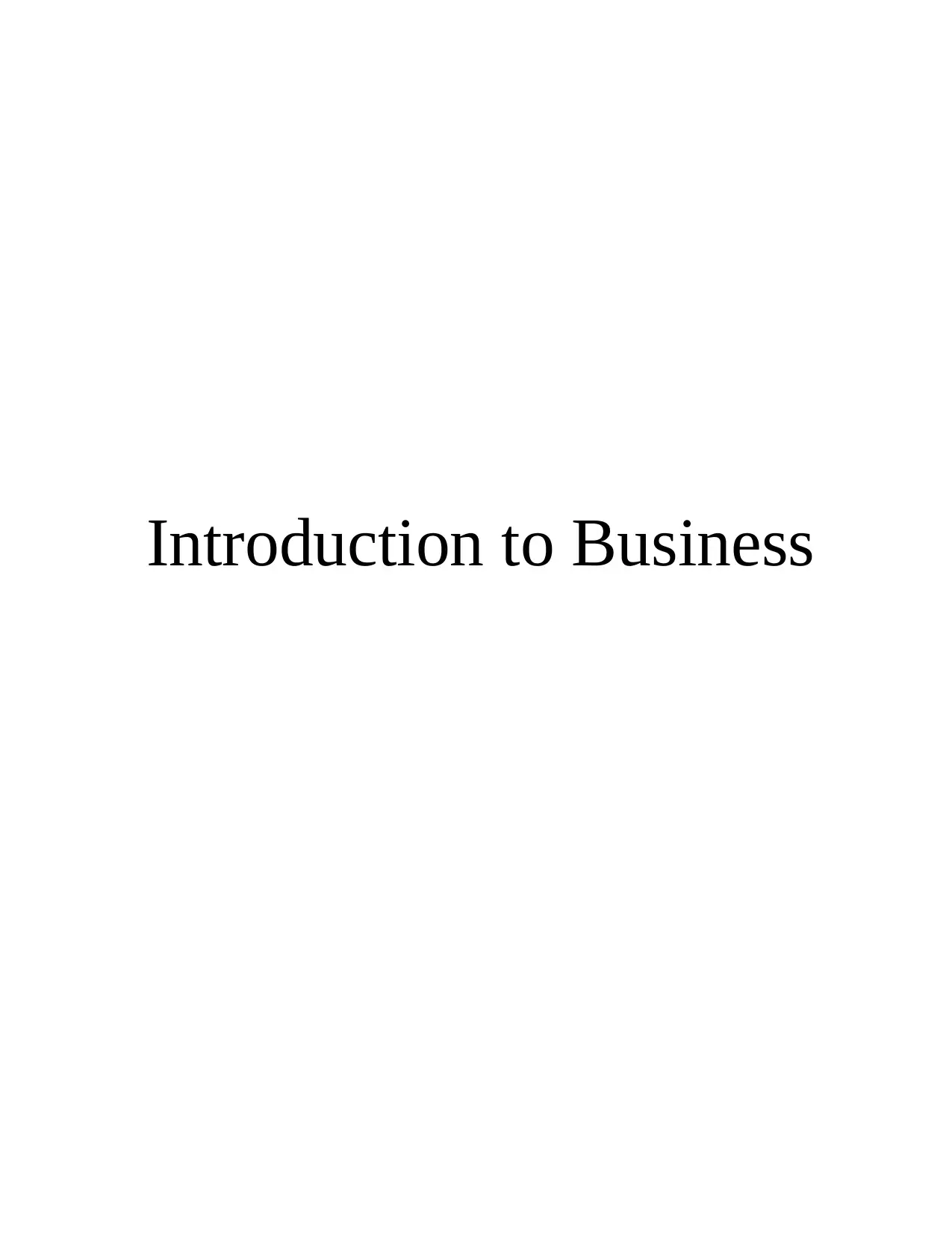
Introduction to Business
Paraphrase This Document
Need a fresh take? Get an instant paraphrase of this document with our AI Paraphraser

Table of Contents
Introduction .....................................................................................................................................3
Task .................................................................................................................................................3
Partnership...................................................................................................................................3
Use of Porters Five Forces to analyse Little Shop Dessert Business..........................................4
How Macro Environmental Factor improves the business.........................................................5
Conclusion ......................................................................................................................................6
REFERENCES................................................................................................................................8
Introduction .....................................................................................................................................3
Task .................................................................................................................................................3
Partnership...................................................................................................................................3
Use of Porters Five Forces to analyse Little Shop Dessert Business..........................................4
How Macro Environmental Factor improves the business.........................................................5
Conclusion ......................................................................................................................................6
REFERENCES................................................................................................................................8
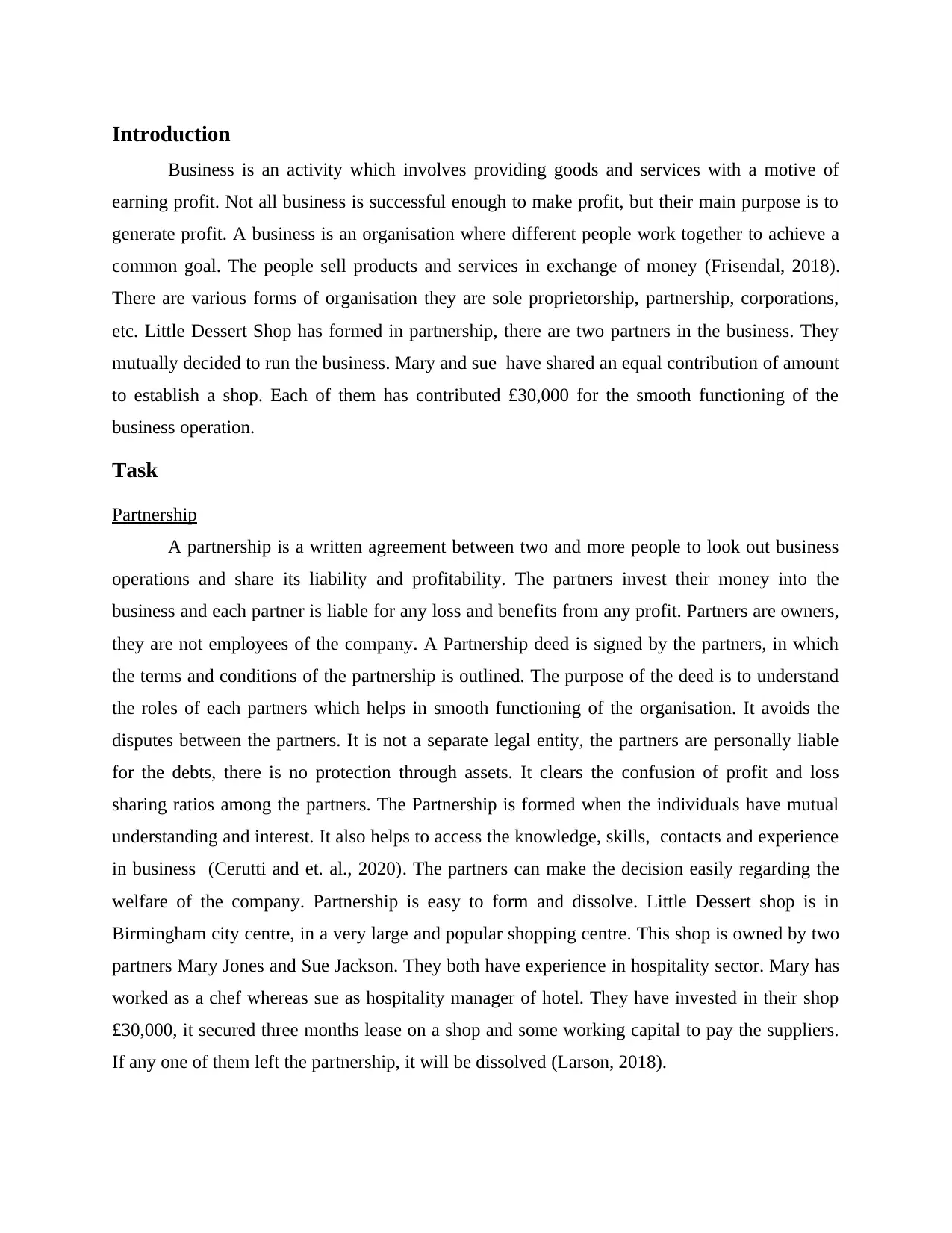
Introduction
Business is an activity which involves providing goods and services with a motive of
earning profit. Not all business is successful enough to make profit, but their main purpose is to
generate profit. A business is an organisation where different people work together to achieve a
common goal. The people sell products and services in exchange of money (Frisendal, 2018).
There are various forms of organisation they are sole proprietorship, partnership, corporations,
etc. Little Dessert Shop has formed in partnership, there are two partners in the business. They
mutually decided to run the business. Mary and sue have shared an equal contribution of amount
to establish a shop. Each of them has contributed £30,000 for the smooth functioning of the
business operation.
Task
Partnership
A partnership is a written agreement between two and more people to look out business
operations and share its liability and profitability. The partners invest their money into the
business and each partner is liable for any loss and benefits from any profit. Partners are owners,
they are not employees of the company. A Partnership deed is signed by the partners, in which
the terms and conditions of the partnership is outlined. The purpose of the deed is to understand
the roles of each partners which helps in smooth functioning of the organisation. It avoids the
disputes between the partners. It is not a separate legal entity, the partners are personally liable
for the debts, there is no protection through assets. It clears the confusion of profit and loss
sharing ratios among the partners. The Partnership is formed when the individuals have mutual
understanding and interest. It also helps to access the knowledge, skills, contacts and experience
in business (Cerutti and et. al., 2020). The partners can make the decision easily regarding the
welfare of the company. Partnership is easy to form and dissolve. Little Dessert shop is in
Birmingham city centre, in a very large and popular shopping centre. This shop is owned by two
partners Mary Jones and Sue Jackson. They both have experience in hospitality sector. Mary has
worked as a chef whereas sue as hospitality manager of hotel. They have invested in their shop
£30,000, it secured three months lease on a shop and some working capital to pay the suppliers.
If any one of them left the partnership, it will be dissolved (Larson, 2018).
Business is an activity which involves providing goods and services with a motive of
earning profit. Not all business is successful enough to make profit, but their main purpose is to
generate profit. A business is an organisation where different people work together to achieve a
common goal. The people sell products and services in exchange of money (Frisendal, 2018).
There are various forms of organisation they are sole proprietorship, partnership, corporations,
etc. Little Dessert Shop has formed in partnership, there are two partners in the business. They
mutually decided to run the business. Mary and sue have shared an equal contribution of amount
to establish a shop. Each of them has contributed £30,000 for the smooth functioning of the
business operation.
Task
Partnership
A partnership is a written agreement between two and more people to look out business
operations and share its liability and profitability. The partners invest their money into the
business and each partner is liable for any loss and benefits from any profit. Partners are owners,
they are not employees of the company. A Partnership deed is signed by the partners, in which
the terms and conditions of the partnership is outlined. The purpose of the deed is to understand
the roles of each partners which helps in smooth functioning of the organisation. It avoids the
disputes between the partners. It is not a separate legal entity, the partners are personally liable
for the debts, there is no protection through assets. It clears the confusion of profit and loss
sharing ratios among the partners. The Partnership is formed when the individuals have mutual
understanding and interest. It also helps to access the knowledge, skills, contacts and experience
in business (Cerutti and et. al., 2020). The partners can make the decision easily regarding the
welfare of the company. Partnership is easy to form and dissolve. Little Dessert shop is in
Birmingham city centre, in a very large and popular shopping centre. This shop is owned by two
partners Mary Jones and Sue Jackson. They both have experience in hospitality sector. Mary has
worked as a chef whereas sue as hospitality manager of hotel. They have invested in their shop
£30,000, it secured three months lease on a shop and some working capital to pay the suppliers.
If any one of them left the partnership, it will be dissolved (Larson, 2018).
⊘ This is a preview!⊘
Do you want full access?
Subscribe today to unlock all pages.

Trusted by 1+ million students worldwide

Use of Porters Five Forces to analyse Little Shop Dessert Business
Porters Five Forces is a framework that identifies and analyse the level of competition
within the certain industries. It is especially used when the firm is entering into the market or
when a new business is starting. There are five forces that helps to determine the competitive
intensity and the attractiveness of the market. It determines the strength and weakness of the
industry. It also helps to ascertain the profit making capability of the organisation and level of
competition in industry. The model is used to overcome the weakness and improve the mistakes
of the Entity.
The five forces that helps in shaping the industry and its competition are as follows-
Competitive rivalry-
It examines the intense of competition in the market which is set by the numbers of competitors
and there capabilities to compete. Little Desert shop has to identify and analyse its competitors in
the market. They should know about its competitors power and attractiveness. Mary and Sue
have to attract the customers by giving better quality of products from their rivalry. They should
offer a healthy products with better price so that customers pull towards their shop (Bruijl,
2018).
New Entrants Into Marketplace-
There are barriers which new entrants have to face while establishing a new business. Any new
brand has to focus on the product quality and the competitors in the market. This threat is
beneficial for the existing organisation they can create a barrier for the new entrants from
entering into the marketplace. Little Dessert Shop has to create a good reputation in the market, it
increases the goodwill and sales. If the shop has a brand value the customers get attracted and
will be loyal towards the product. As new entrants can be threat for the Little Desert Shop they
have to compete with them in price, quality, services and many other factors.
Threat of Substitutes product-
This force determines how easy it is for the competitors to join the market. The substitute
product increases the likelihood of the customers for switching to alternatives in response to
price and quality. Little Dessert Shop should identify their substitute products in the market, they
need to change their prices and quality according to it. The high threat of the substitute product
reduces the profit margin and also affects the growth of the company.
Bargaining Power of Supplier-
Porters Five Forces is a framework that identifies and analyse the level of competition
within the certain industries. It is especially used when the firm is entering into the market or
when a new business is starting. There are five forces that helps to determine the competitive
intensity and the attractiveness of the market. It determines the strength and weakness of the
industry. It also helps to ascertain the profit making capability of the organisation and level of
competition in industry. The model is used to overcome the weakness and improve the mistakes
of the Entity.
The five forces that helps in shaping the industry and its competition are as follows-
Competitive rivalry-
It examines the intense of competition in the market which is set by the numbers of competitors
and there capabilities to compete. Little Desert shop has to identify and analyse its competitors in
the market. They should know about its competitors power and attractiveness. Mary and Sue
have to attract the customers by giving better quality of products from their rivalry. They should
offer a healthy products with better price so that customers pull towards their shop (Bruijl,
2018).
New Entrants Into Marketplace-
There are barriers which new entrants have to face while establishing a new business. Any new
brand has to focus on the product quality and the competitors in the market. This threat is
beneficial for the existing organisation they can create a barrier for the new entrants from
entering into the marketplace. Little Dessert Shop has to create a good reputation in the market, it
increases the goodwill and sales. If the shop has a brand value the customers get attracted and
will be loyal towards the product. As new entrants can be threat for the Little Desert Shop they
have to compete with them in price, quality, services and many other factors.
Threat of Substitutes product-
This force determines how easy it is for the competitors to join the market. The substitute
product increases the likelihood of the customers for switching to alternatives in response to
price and quality. Little Dessert Shop should identify their substitute products in the market, they
need to change their prices and quality according to it. The high threat of the substitute product
reduces the profit margin and also affects the growth of the company.
Bargaining Power of Supplier-
Paraphrase This Document
Need a fresh take? Get an instant paraphrase of this document with our AI Paraphraser
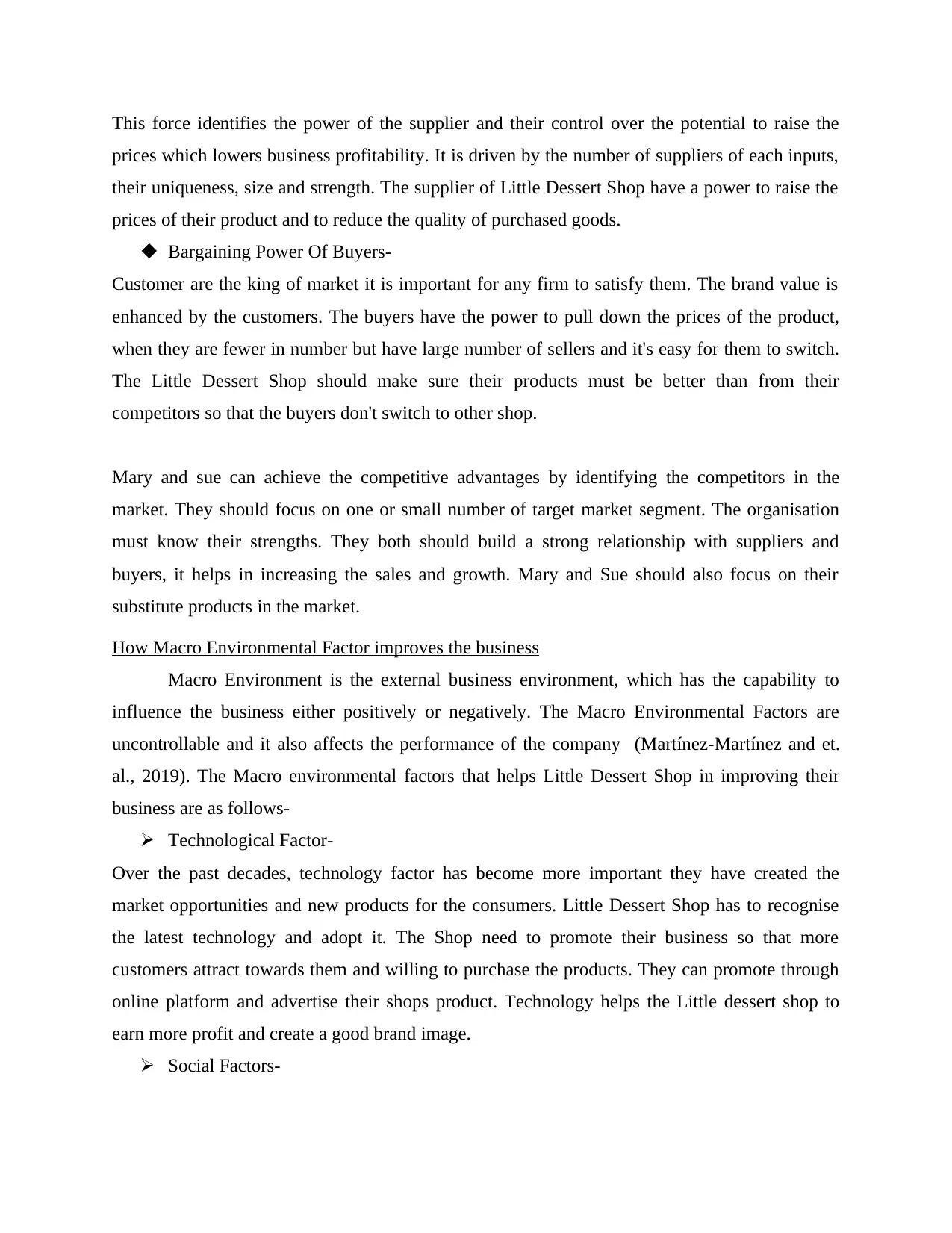
This force identifies the power of the supplier and their control over the potential to raise the
prices which lowers business profitability. It is driven by the number of suppliers of each inputs,
their uniqueness, size and strength. The supplier of Little Dessert Shop have a power to raise the
prices of their product and to reduce the quality of purchased goods.
Bargaining Power Of Buyers-
Customer are the king of market it is important for any firm to satisfy them. The brand value is
enhanced by the customers. The buyers have the power to pull down the prices of the product,
when they are fewer in number but have large number of sellers and it's easy for them to switch.
The Little Dessert Shop should make sure their products must be better than from their
competitors so that the buyers don't switch to other shop.
Mary and sue can achieve the competitive advantages by identifying the competitors in the
market. They should focus on one or small number of target market segment. The organisation
must know their strengths. They both should build a strong relationship with suppliers and
buyers, it helps in increasing the sales and growth. Mary and Sue should also focus on their
substitute products in the market.
How Macro Environmental Factor improves the business
Macro Environment is the external business environment, which has the capability to
influence the business either positively or negatively. The Macro Environmental Factors are
uncontrollable and it also affects the performance of the company (Martínez-Martínez and et.
al., 2019). The Macro environmental factors that helps Little Dessert Shop in improving their
business are as follows-
Technological Factor-
Over the past decades, technology factor has become more important they have created the
market opportunities and new products for the consumers. Little Dessert Shop has to recognise
the latest technology and adopt it. The Shop need to promote their business so that more
customers attract towards them and willing to purchase the products. They can promote through
online platform and advertise their shops product. Technology helps the Little dessert shop to
earn more profit and create a good brand image.
Social Factors-
prices which lowers business profitability. It is driven by the number of suppliers of each inputs,
their uniqueness, size and strength. The supplier of Little Dessert Shop have a power to raise the
prices of their product and to reduce the quality of purchased goods.
Bargaining Power Of Buyers-
Customer are the king of market it is important for any firm to satisfy them. The brand value is
enhanced by the customers. The buyers have the power to pull down the prices of the product,
when they are fewer in number but have large number of sellers and it's easy for them to switch.
The Little Dessert Shop should make sure their products must be better than from their
competitors so that the buyers don't switch to other shop.
Mary and sue can achieve the competitive advantages by identifying the competitors in the
market. They should focus on one or small number of target market segment. The organisation
must know their strengths. They both should build a strong relationship with suppliers and
buyers, it helps in increasing the sales and growth. Mary and Sue should also focus on their
substitute products in the market.
How Macro Environmental Factor improves the business
Macro Environment is the external business environment, which has the capability to
influence the business either positively or negatively. The Macro Environmental Factors are
uncontrollable and it also affects the performance of the company (Martínez-Martínez and et.
al., 2019). The Macro environmental factors that helps Little Dessert Shop in improving their
business are as follows-
Technological Factor-
Over the past decades, technology factor has become more important they have created the
market opportunities and new products for the consumers. Little Dessert Shop has to recognise
the latest technology and adopt it. The Shop need to promote their business so that more
customers attract towards them and willing to purchase the products. They can promote through
online platform and advertise their shops product. Technology helps the Little dessert shop to
earn more profit and create a good brand image.
Social Factors-
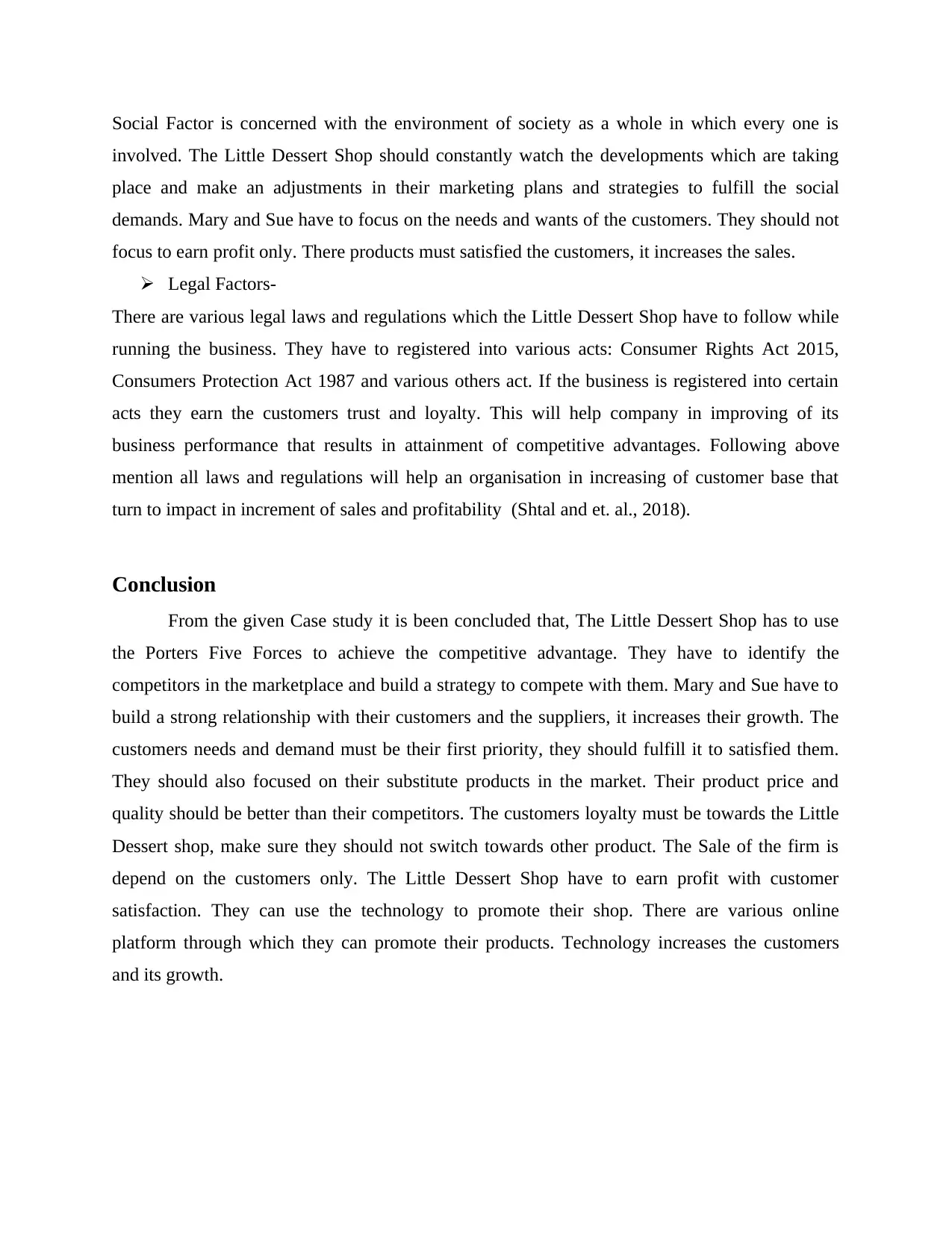
Social Factor is concerned with the environment of society as a whole in which every one is
involved. The Little Dessert Shop should constantly watch the developments which are taking
place and make an adjustments in their marketing plans and strategies to fulfill the social
demands. Mary and Sue have to focus on the needs and wants of the customers. They should not
focus to earn profit only. There products must satisfied the customers, it increases the sales.
Legal Factors-
There are various legal laws and regulations which the Little Dessert Shop have to follow while
running the business. They have to registered into various acts: Consumer Rights Act 2015,
Consumers Protection Act 1987 and various others act. If the business is registered into certain
acts they earn the customers trust and loyalty. This will help company in improving of its
business performance that results in attainment of competitive advantages. Following above
mention all laws and regulations will help an organisation in increasing of customer base that
turn to impact in increment of sales and profitability (Shtal and et. al., 2018).
Conclusion
From the given Case study it is been concluded that, The Little Dessert Shop has to use
the Porters Five Forces to achieve the competitive advantage. They have to identify the
competitors in the marketplace and build a strategy to compete with them. Mary and Sue have to
build a strong relationship with their customers and the suppliers, it increases their growth. The
customers needs and demand must be their first priority, they should fulfill it to satisfied them.
They should also focused on their substitute products in the market. Their product price and
quality should be better than their competitors. The customers loyalty must be towards the Little
Dessert shop, make sure they should not switch towards other product. The Sale of the firm is
depend on the customers only. The Little Dessert Shop have to earn profit with customer
satisfaction. They can use the technology to promote their shop. There are various online
platform through which they can promote their products. Technology increases the customers
and its growth.
involved. The Little Dessert Shop should constantly watch the developments which are taking
place and make an adjustments in their marketing plans and strategies to fulfill the social
demands. Mary and Sue have to focus on the needs and wants of the customers. They should not
focus to earn profit only. There products must satisfied the customers, it increases the sales.
Legal Factors-
There are various legal laws and regulations which the Little Dessert Shop have to follow while
running the business. They have to registered into various acts: Consumer Rights Act 2015,
Consumers Protection Act 1987 and various others act. If the business is registered into certain
acts they earn the customers trust and loyalty. This will help company in improving of its
business performance that results in attainment of competitive advantages. Following above
mention all laws and regulations will help an organisation in increasing of customer base that
turn to impact in increment of sales and profitability (Shtal and et. al., 2018).
Conclusion
From the given Case study it is been concluded that, The Little Dessert Shop has to use
the Porters Five Forces to achieve the competitive advantage. They have to identify the
competitors in the marketplace and build a strategy to compete with them. Mary and Sue have to
build a strong relationship with their customers and the suppliers, it increases their growth. The
customers needs and demand must be their first priority, they should fulfill it to satisfied them.
They should also focused on their substitute products in the market. Their product price and
quality should be better than their competitors. The customers loyalty must be towards the Little
Dessert shop, make sure they should not switch towards other product. The Sale of the firm is
depend on the customers only. The Little Dessert Shop have to earn profit with customer
satisfaction. They can use the technology to promote their shop. There are various online
platform through which they can promote their products. Technology increases the customers
and its growth.
⊘ This is a preview!⊘
Do you want full access?
Subscribe today to unlock all pages.

Trusted by 1+ million students worldwide
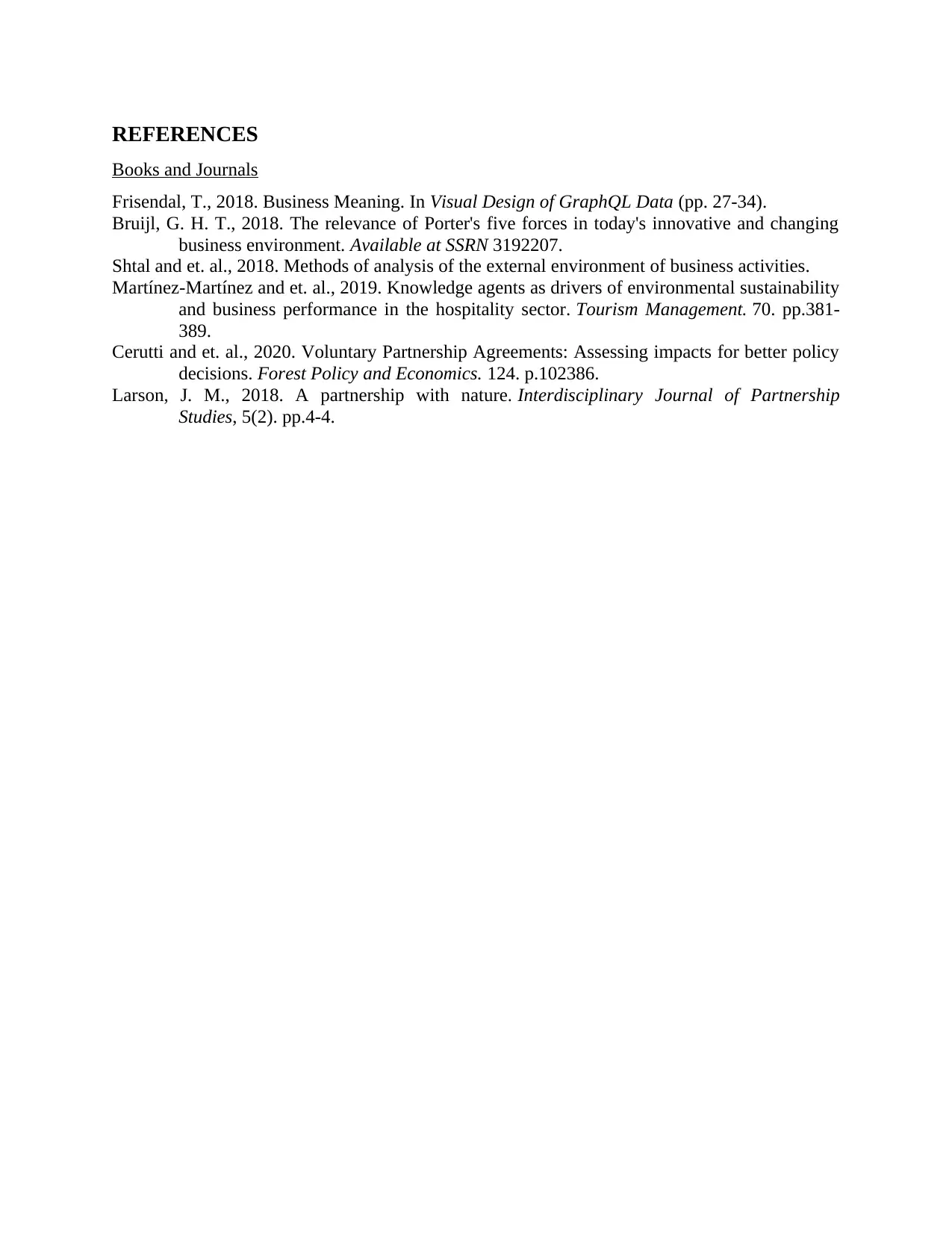
REFERENCES
Books and Journals
Frisendal, T., 2018. Business Meaning. In Visual Design of GraphQL Data (pp. 27-34).
Bruijl, G. H. T., 2018. The relevance of Porter's five forces in today's innovative and changing
business environment. Available at SSRN 3192207.
Shtal and et. al., 2018. Methods of analysis of the external environment of business activities.
Martínez-Martínez and et. al., 2019. Knowledge agents as drivers of environmental sustainability
and business performance in the hospitality sector. Tourism Management. 70. pp.381-
389.
Cerutti and et. al., 2020. Voluntary Partnership Agreements: Assessing impacts for better policy
decisions. Forest Policy and Economics. 124. p.102386.
Larson, J. M., 2018. A partnership with nature. Interdisciplinary Journal of Partnership
Studies, 5(2). pp.4-4.
Books and Journals
Frisendal, T., 2018. Business Meaning. In Visual Design of GraphQL Data (pp. 27-34).
Bruijl, G. H. T., 2018. The relevance of Porter's five forces in today's innovative and changing
business environment. Available at SSRN 3192207.
Shtal and et. al., 2018. Methods of analysis of the external environment of business activities.
Martínez-Martínez and et. al., 2019. Knowledge agents as drivers of environmental sustainability
and business performance in the hospitality sector. Tourism Management. 70. pp.381-
389.
Cerutti and et. al., 2020. Voluntary Partnership Agreements: Assessing impacts for better policy
decisions. Forest Policy and Economics. 124. p.102386.
Larson, J. M., 2018. A partnership with nature. Interdisciplinary Journal of Partnership
Studies, 5(2). pp.4-4.
1 out of 7
Related Documents
Your All-in-One AI-Powered Toolkit for Academic Success.
+13062052269
info@desklib.com
Available 24*7 on WhatsApp / Email
![[object Object]](/_next/static/media/star-bottom.7253800d.svg)
Unlock your academic potential
Copyright © 2020–2025 A2Z Services. All Rights Reserved. Developed and managed by ZUCOL.





